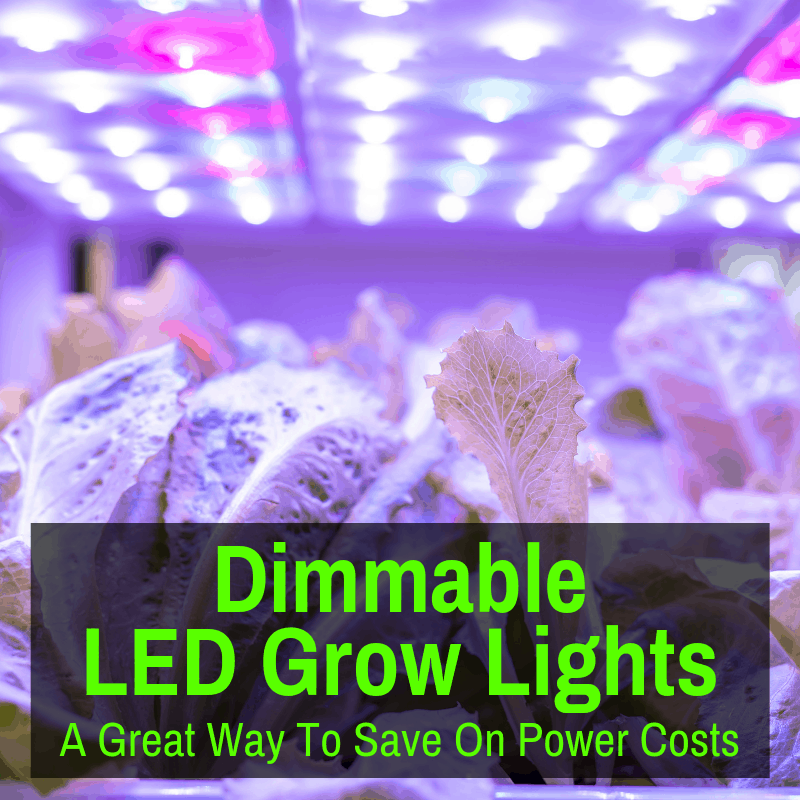
I admit, I thought there were far more of them.
But when I started researching, I mainly found the ones I already knew about and few others.
And most of those “others” are not great.
In the end, all of the lights below are either quantum boards or bar style lights.
I suppose that is fine, since those are currently the best and most popular types of lights on the market.
But I was hoping to find at least one good dimmable blurple or COB light for those who prefer them.
Be that as it may, keep reading for the best dimmable LED grow lights currently available.
Contents
- 1 Dimmable LED Grow Lights Compared
- 2 Best Dimmable LED Grow Lights Reviewed
- 2.1 Best Dimmable LED Grow Light Overall: Spider Farmer SE Series Bar LED Grow Lights
- 2.2 Best Dimmable Quantum Board Lights: HLG LED Grow Lights
- 2.3 Best Budget Bar Lights: Viparspectra KS Series
- 2.4 Best Budget Quantum Boards: Spider Farmer SF Series
- 2.5 Alternative Bar Light: Mars Hydro FC Series
- 2.6 Alternative Quantum Board Lights: Viparspectra XS Series
- 3 Dimmable LED Grow Lights: Final Thoughts
Dimmable LED Grow Lights Compared
Best Dimmable LED Grow Lights Reviewed
These are the top 6 dimmable horticultural LED fixtures currently available. I’ll begin with the best bar light (and the best overall), and then follow with the best quantum board light, the best budget alternatives for each, and two more good alternatives.
I decided not to look at individual light fixtures here, but at series. Each series has several fixtures of different sizes. The final two alternatives are series I would check out, if the other options do not have fixtures in the size you need.
Best Dimmable LED Grow Light Overall: Spider Farmer SE Series Bar LED Grow Lights
- Samsung LM301B diodes — extremely efficient, achieving 2.75 umol/J
- Full spectrum light — can be used during all stages of growth, with white light plus deep red, UV and IR for a bloom boost
- Large even coverage — large form factor and spread out bars makes for a more even light distribution
- Daisy chainable — connect up to 30 lights
- Runs on AC100-240V — SE lights will work at any standard voltage (except SE1000W, which needs 220v)
- Rated for 100,000 hours — 8-10 years with no light bulb changes
- Includes light, hanging kit and power cord — everything you need to start growing immediately
The Spider Farmer SE series are our favorite bar style LED grow lights for one simple reason. They offer the best value on the market today.
Yes, brands like Fluence and Gavita make slightly better lights (although the difference is constantly getting smaller), but they also cost two or three times as much. The difference is not worth that. Not even close.
And yes, there are cheaper lights than the Spider Farmer ones. We review two of them below. But Spider Farmer gives you better quality control and customer service than other Chinese brands. And that makes the difference.
They also use quality components like the industry-leading Samsung LM301B diodes. Those are the reason the Spider Farmer SE series is one of the most efficient line of lights on the market, delivering 2.75 umol per joule.
There are two famous US brands that also use the same high-end components (Growers Choice and Optic LED), but they cost a bit more.
More importantly, they manufacture their lights in China and actually have much worse quality control and customer service than Spider Farmer. In fact, they are on par with some of the worst brands from China.
In other words, you’re paying more to get less, simply because they label themselves as a US brand, despite not making their lights here. That’s why those brands are not on this list.
As for the SE series, some other great features are the perfect spectrum for plants, especially for flowering. A mix of 3000K and 5000K white light, with 660 nm deep red, 740 nm infrared and 400 nm UV gives you a full spectrum light that contains all wavelengths, with peaks in blue and red.
It is exactly the light plants crave and the light they get from the sun itself, with a few improvements.
You can daisy chain together multiple lights and you can even dim them all together as one. That is a feature few other brands offer. The ones that do tend to cost a lot more.
In short, there is currently no better value on the market than the Spider Farmer SE series. There are a few that come close and some of them are even dimmable. You can read about those lights next.
Pros
- Perfect spectrum for all stages of plant growth
- High quality components (Samsung chips and quality driver)
- Great efficiency of 2.75 umol/J
- Passive cooling (no noisy fans)
- Yield of 2.2 grams per watt
- 3 year warranty and 30 day money back guarantee
Cons
- Slightly higher price than other Chinese brands
Best Dimmable Quantum Board Lights: HLG LED Grow Lights
- Incredibly efficient — 2.55 μmol/joule means you get far more output for electricity consumed
- Dimmable — save money on electricity when you don’t need full power
- Daisy chain — connect several lights together and run them from a single outlet (only some fixtures)
- Large even coverage — large form factor makes for a more even light distribution
- Quantum boards — with Samsung LM301H white and additional red or blue diodes
- Dimmable driver — top quality driver, dimmable to 10% intensity
- Perfect spectrum for plants — warm or cool white light plus deep red or blue (depending on fixture)
- Includes 3-year warranty — if you do get a bad unit, you can get it replaced
Horticultural Lighting Group pioneered the quantum board style lights. They took the industry by storm and pretty soon, every Chinese brand had their own line of HLG knockoffs. The better ones even improved on the HLG fixtures, while still selling for a lower price.
Of course, HLG saw this and made improvements of their own. They also moved production from China to Tennessee and fixed their other weaknesses, most notably customer service.
The result is perhaps the best LED grow light brand period. Their lights do cost a bit more, but they have come down a lot in price and are now not much more expensive than the better Chinese brands.
The one thing HLG has not done is release a line of bar style lights. Instead, they have released new quantum board fixtures that emulate the bar style lights in a pretty innovative way. These are their new scorpion lights.
You can see all of the HLG lights in our full review of the brand here.
HLG makes different types of quantum boards that all feature slightly different light spectra. They all use all-white light, but some use warmer light, while others use cooler light. The former ar stronger for flowering, while the latter are stronger for vegging.
The flowering boards have additional deep red diodes for a boost during flowering, similar to the Spider Farmer lights. This is one of the innovations HLG took from the competitors that had copied their lights and improved on them.
But what HLG further improved is that they also have lights that specialize in vegging with cooler white diodes and additional blue diodes added in. That’s something I have not seen any other brand do yet.
Of course, that is in large part because the quantum spectrum is already great at vegging. It makes no sense to use a separate light for vegging and flowering, unless you have a separate room for each. Then the HLG vegging specialists are perfect.
HLG also uses Samsung diodes. A big difference between them and some of the other brands is that you can not daisy chain all HLG fixtures. Only some of them can be connected in series.
The biggest advantage of HLG fixtures is track record. In terms of quality control and customer service, they are far better than any Chinese brands. More importantly, their lights have been on the market for a while and have a proven track record of success.
Pros
- High quality components (Samsung chips and high-quality driver)
- Highly efficient
- Longest track record of success
- Passive cooling (no noisy fans)
- Vegging specialist fixtures available
Cons
- Spectrum does not contain UV and IR
- Not all fixtures are daisy-chainable
Best Budget Bar Lights: Viparspectra KS Series
- Samsung LM301B chips and MeanWell driver — highly efficient with an output of around 2.7 umol/J (but not as high as advertised)
- Full spectrum light — warm and cool white light, plus deep red, and IR; great for all stages of plant growth, especially bloom
- Even light spread — plants around the outside of coverage area still get a lot of light
- Passive cooling — no noisy fans in the fixture
- Daisy-chainable — connect up to 100 lights and dim them all together
- Detachable driver — put driver outside tent to keep heat down, with extra long 16 ft power cable
- 3-year warranty and 90 day return guarantee— risk-free purchase
Viparspectra is one of the aforementioned Chinese brands that jumps on every bandwagon in the industry. As such, they have both a bar light series and a quantum board series.
We’ll take a look at the quantum one further below. Here, we tackle the bar lights from Viparspectra.
At first glance, they look just like any other bar lights. And they basically are. They usually sell for a bit less than the Spider Farmer lights, which is why they are our favorite budget pick.
Even though they are almost identical, we prefer Spider Farmer, since they are overall a bit better with quality control and customer service. But Viparspectra also has a US service center these days, so their service is much improved, too. That said, it could still be a lot better. But for a Chinese brand, they are very good.
As for the actual fixtures, they also use the Samsung LM301B diodes. Specifically, they use 3000K and 5000K diodes. They supplement them with 660 nm deep red diodes from Osram, as well as 730 nm infrared. They do not have any UV diodes.
Viparspectra claims an incredible efficiency of 3.1 umol/J. However, this is almost certainly exaggerated, which is something Chinese brands love to do. I mean, think about it. They use the same diodes as Spider Farmer, but the are suddenly s much more efficient?
I don’t think so. And a perfect illustration of why we prefer Spider Farmer. They don’t exaggerate quite as much as most other Chinese brands. To be fair, Viparspectra is much better than most, too, but I wish they would just cut that BS out altogether.
You can not daisy chain these lights. But you can detach the driver and keep it outside the tent, to keep temperatures down a bit. Of course, that is possible with all of the brands here. Viparspectra do give you a 17 foot power cord to make this easier, which is not something many other brands do.
They also warranty their lights for 3 years, which is basically now the industry standard. The same goes for the 30 day money back guarantee.
Pros
- Lower price
- High quality components, like Samsung LM301B chips
- Highly efficient (though not as efficient as they claim)
- Great spectrum with 3000K and 5000K white, plus 660 nm deep red and 730 nm IR
- Passive cooling (no noisy fans)
- Daisy chainable
- 3 year warranty and 30 day money back guarantee
Cons
- Lacks UV
- Quality control and customer service not as good as top brands
Best Budget Quantum Boards: Spider Farmer SF Series
- Extremely efficient — output of 2.7 umol per joule
- Samsung LM301B diodes — industry standard and the reason for the high efficiency
- Full spectrum light — can be used during all stages of growth, with white light plus red for a bloom boost
- Large even coverage — large form factor makes for a more even light distribution
- Daisy-chainable — connect up to 60 lights and dim them all together
- 3 year warranty — you also get a 30 day money back guarantee
- Rated for 55,000 hours — 4-5 years with no light bulb changes
- Includes light, hanging kit and power cord — everything you need to start growing immediately
For a while, Spider Farmer was the only brand to combine warm white, cool white, deep red and IR diodes in one fixture. As mentioned above, other brands now do the same. Even HLG added red (or blue), but no IR.
Specifically, the SF series fixtures use 3000K and 5000K white light, red light with a wavelength of 660 nm and infrared light with a wavelength of 760 nm. This spectrum has been shown to give bigger and higher quality yields than one containing only white light.
They do not have UV light, like the SE series we reviewed above. However, none of the competition has UV in their fixtures either. And that is something you can always just supplement by adding a fluorescent UV bulb to your grow room for a few hours a day.
As with the SE series, Spider Farmer uses top-bin LED chips from Samsung in the SF series. That means this series of lights is also highly efficient at 2.7 umol/J.
Spider Farmer lights have a more solid build than much of the competition. You can see that just looking at the photos. As mentioned, they cost less than HLG lights, but usually slightly more than other Chinese brands. But sometimes they are cheaper, so keep your eyes out for deals.
This series by Spider Farmer includes the SF 1000, SF 2000, SF 4000, and SF 7000 lights. You can see them all compared in our Spider Farmer review.
All of them allow you to daisy chain up to 60 lights. You can also detach the driver. The power cord is only 8.5 feet long. That is usually long enough to put the driver outside the tent, but not always. It certainly falls short of Viparspectra’s 17 foot cord on their KS series.
You get a 3 year warranty with your purchase of any of these lights and you can return the light within 30 days.
Pros
- Perfect spectrum for all stages of plant growth
- High quality components (Samsung chips and high quality driver)
- Excellent efficiency at 2.7 umol/J
- Passive cooling (no noisy fans)
- Yield of 2.2 grams per watt
- 3 year warranty and 30 day money back guarantee
Cons
- Slightly higher price
- Power cord not as long as some competitors (but longer than most)
Alternative Bar Light: Mars Hydro FC Series
- Samsung LM301B chips — highly efficient with an output of around 2.7 umol/J
- Full spectrum light — warm and cool white light, plus deep red, UV and IR; great for all stages of plant growth, especially flowering
- Even light spread — plants around the outside of coverage area still get a lot of light
- Passive cooling — no noisy fans in the fixture
- Daisy-chainable — connect up to 30 lights and dim them all together
- Detachable driver — put driver outside tent to keep heat down
- Foldable — some fixtures in the series fold in half for easier transport and storage
- 3-year warranty and 90 day return guarantee— risk-free purchase
The differences between Mars Hydro and Viparspectra are not huge. We tend to prefer Viparspectra, due to some bad experiences growers we know have had with Mars. As a brand, they have a bit of difficulty with the truth sometimes.
Again, that is something all Chinese brands tend to have in common. But Mars was actively involved in stamping out criticism for a while and that just left a bit of a bad taste in our mouths. We’re not sure if they are still doing this.
That aside, there is little difference, as mentioned. Your best bet is probably to see which brand has a fixture in the size you need and which one has a better deal going at the moment.
In terms of spectrum, Mars is basically using the exact same diodes as Spider Farmer in their SE series. This means they also have UV light, which could be a slight advantage over Viparspectra, depending on how you feel about UV.
They advertise an efficiency of 2.85 umol/J, a number that seems picked out of thin air to be just slightly ahead of Spider Farmer. Once they notice Viparspectra’s higher claim, they may bump theirs up.
Or perhaps, they have learned and decided to stick to a somewhat more reasonable number.
Either way, I don;t believe it for a minute, and the same goes for their claimed 3 grams per watt yield. Realistically, they are probably very similar to Spider Farmer and Viparspectra in terms of both efficiency and yield.
Like Spider Farmer, you can also daisy chain these lights and dim them all together as one. One feature that sets them apart is that you can fold them for easier transport and storage. Not something I’ve ever needed, but perhaps you do.
If you would like to pay even less, Mars Hydro also has their FC-E series, which is similar to this one, but uses lesser components. This saves you money, but it also lowers the efficiency. I’d only consider it if you don’t have the budget for a light with Samsung diodes.
You can see those lights in our full review of Mars Hydro lights here.
Finally, Mars Hydro warrants these lights for 5 years, which is 2 years more than other brands. They do a lot better with their customer service these days, too, but they still get a lot of returns, so they still have quality control issues.
Pros
- Highly efficient
- High quality components (Samsung chips and quality driver)
- Passive cooling (no noisy fans)
- Daisy-chainable
- 5 year warranty
Cons
- All white spectrum not as good as one with additional red and IR
- Exaggerated claims (still!)
- Quality control and customer service not as good as top brands
Alternative Quantum Board Lights: Viparspectra XS Series
- Samsung LM301B chips and MeanWell driver — highly efficient with an output of around 2.7 umol/J (but not as high as advertised)
- Full spectrum light — warm and cool white light, plus deep red, and IR; great for all stages of plant growth, especially bloom
- Even light spread — plants around the outside of coverage area still get a lot of light
- Passive cooling with true heat sink — no noisy fans and heat sink superior to competitors with just an aluminum panel
- 3-year warranty and 90 day return guarantee— risk-free purchase
Finally, we have our alternative for quantum board lights. We also considered Mars Hydro here, but went with Viparspectra, because we prefer the brand as mentioned. However, in this case, the equivalent Mars series does have some shortcoming (they use lesser components).
The spectrum on these lights will seem familiar to you: 3000K and 5000K white light, with 660 nm red and 730 nm IR. No UV. Once again, we have the Samsung LM301B chips. In this case, we also have a MeanWell driver.
Every brand used these in the past (it started with HLG). However, other brands have started making their own (most likely in the same factory as MeanWell). In some cases, this has resulted in a better efficiency, but some brands have also switched to save money. That never works out well.
Be that as it may, here we have the real thing: a driver by Meanwell. That is the main thing that sets this series apart, although the replacement drivers being used by Spider Farmer and HLG, for example, as every bit as good. Perhaps even better since they are specifically designed for their lights.
You can not daisy chain these lights, and you can’t really detach the driver and put it outside your tent. You can, but it’s not meant to simply detach, so it would take some work. A short power cord also makes it difficult. You’ll need to replace it with a longer one, if you want to detach the driver.
If you are on more of a budget, Viparspectra also has their Pro series of lights. They use lesser components, which reduces the cost. It also reduces efficiency, of course. You can see all of their light series in our full review of Viparspectra lights here.
This light comes with a 3 year warranty and also a 30 day money back guarantee. As mentioned, this is the industry standard nowadays, and you really don’t want to see a brand offer less.
Pros
- High quality components (Samsung LM301B chips and Meanwell driver)
- True heat sink for better heat dissipation
- Great spectrum for plants, especially during flowering
- 3 year warranty and 30 day money back guarantee
Cons
- Short power cord
- No UV light in spectrum
- Quality control and customer service not as good as top brands
Dimmable LED Grow Lights: Final Thoughts
As mentioned in the beginning, all of the lights here are full-spectrum white lights, with some additional diodes. Those seem to be the lights that are easiest to make dimmable.
We did find some COB fixtures and some blurple fixtures that were dimmable, but none of them were especially good. Certainly not something we would want to recommend.
Or they were simply far too expensive for what you get (this was the case with Optic LED, which does have some dimmable COB fixtures).
However, since most growers prefer the bar-style lights these days, it does not matter all that much. When it comes to bar lights (and also quantum boards), they are basically all dimmable. You can choose from any of them, with the above 6 light series being the best available.
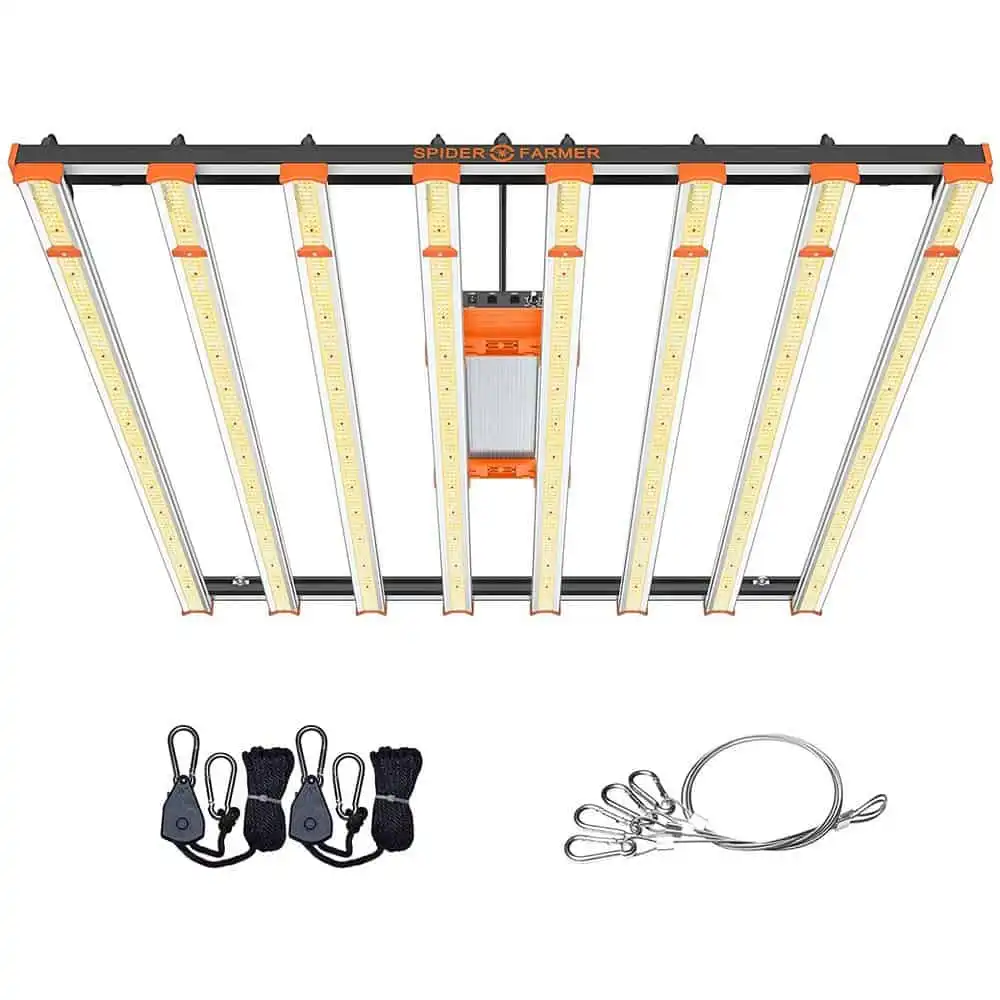
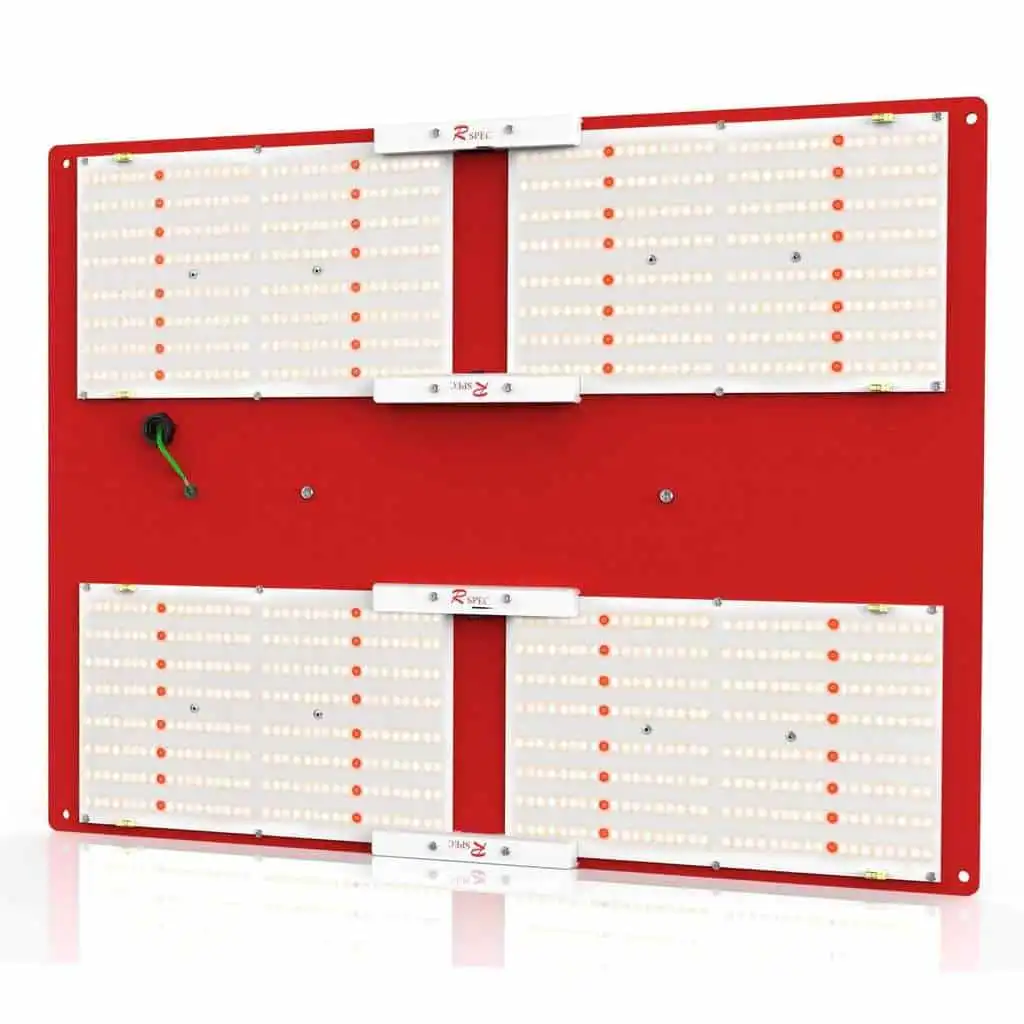
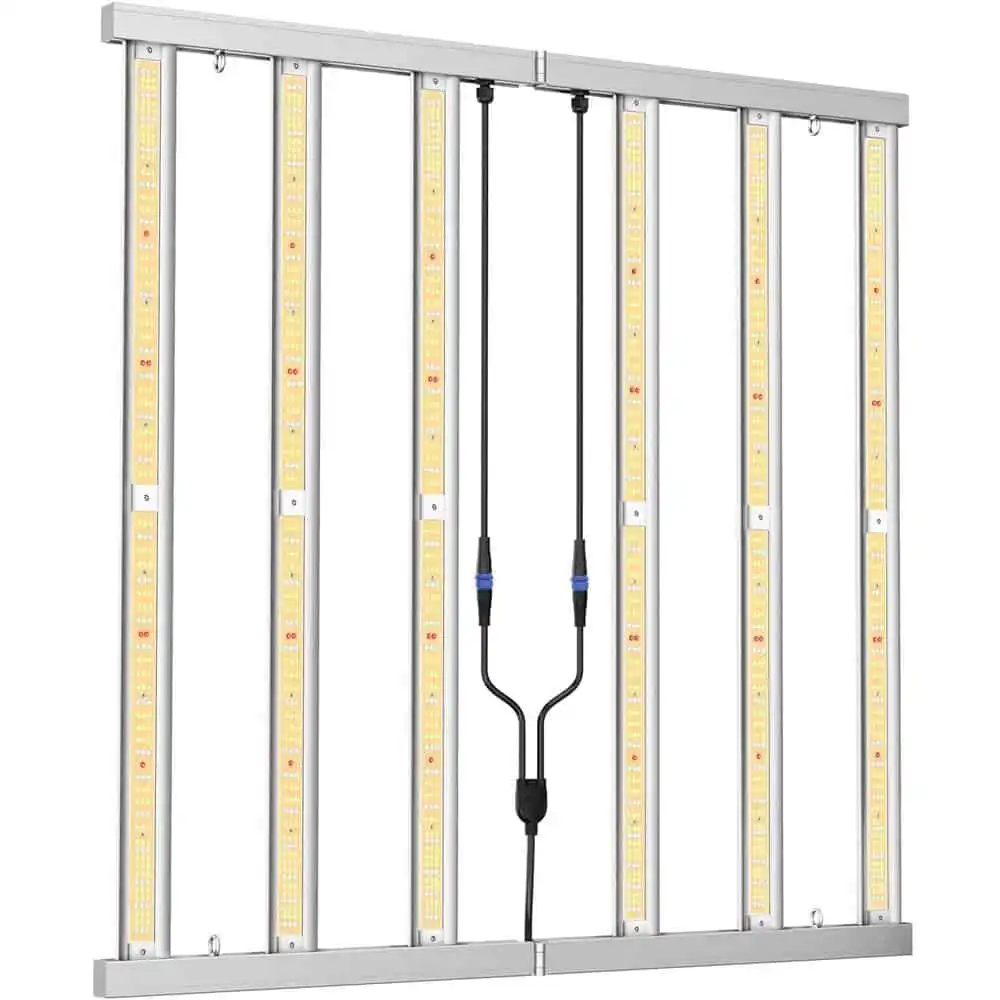
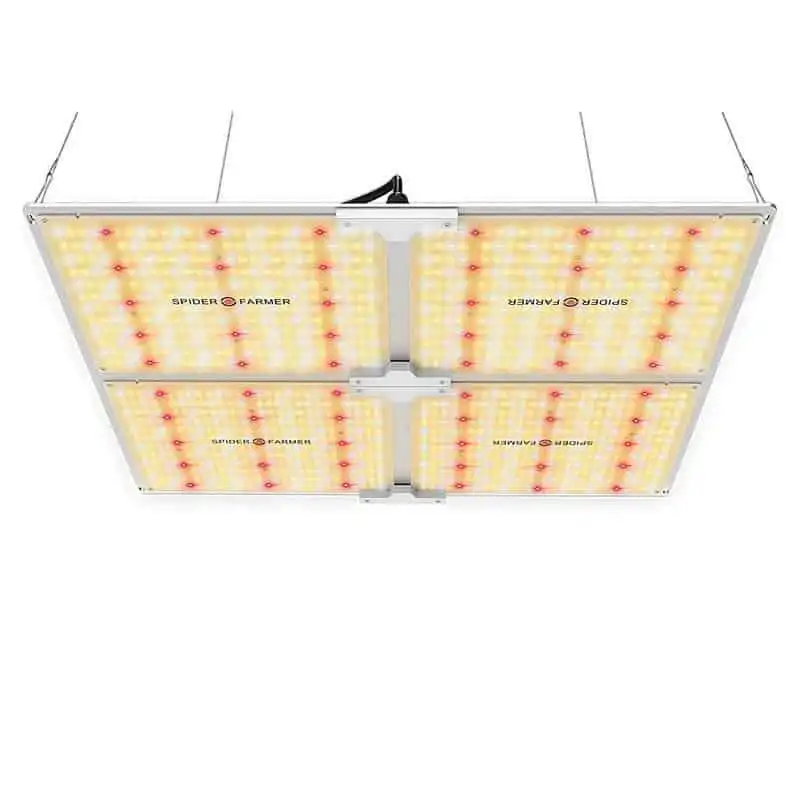
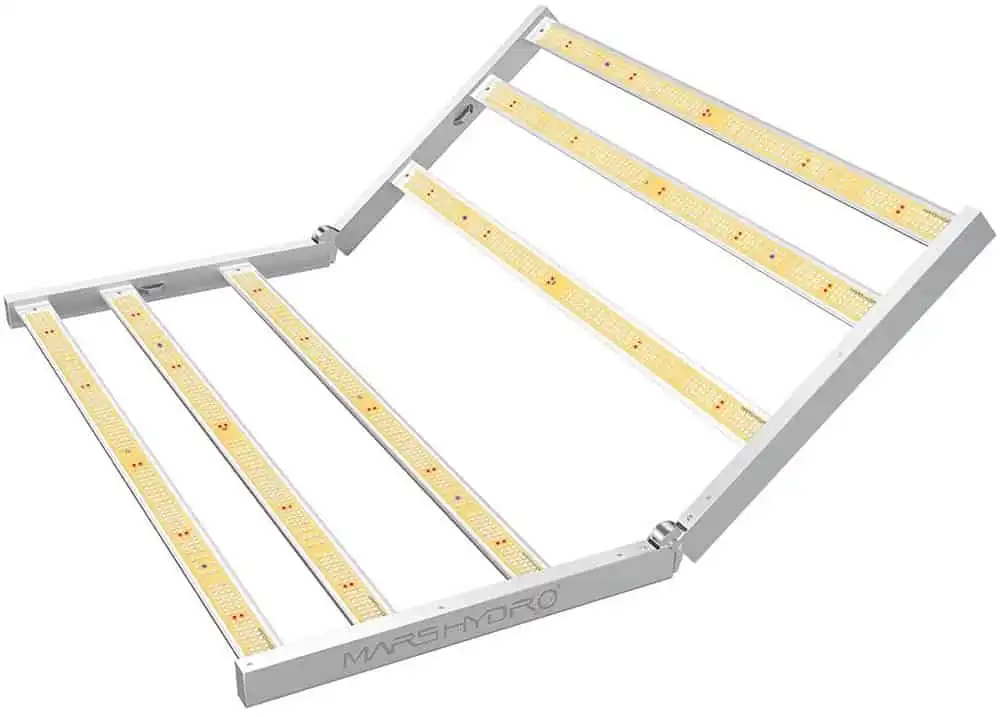
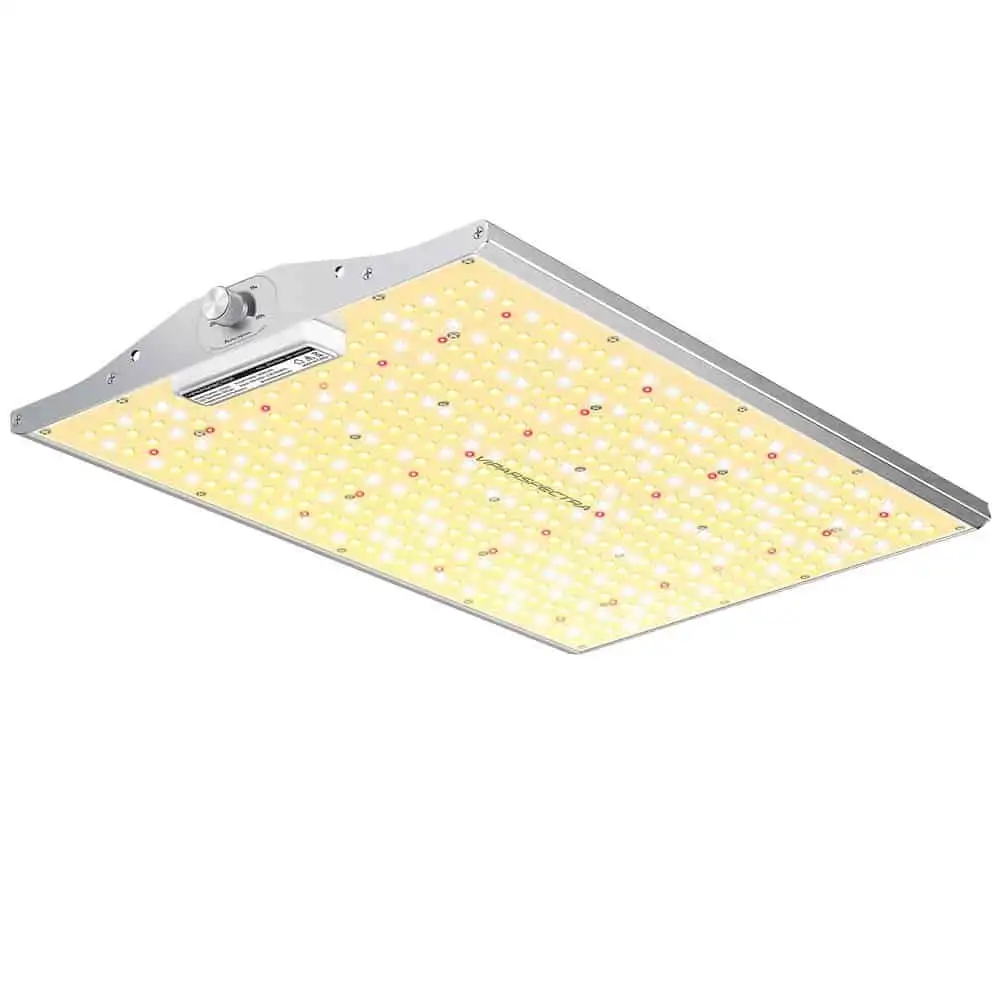
Can anyone tell,e of the Spiderfarmer dimmer has any setting numbers or other indicators that tell you how much it is being dimmed?
It does not. It is just a little screw hole that you turn.
The lenofocus actually does have IR diodes now, Ive been using mine for about 2 months and its stellar!
For the viparspectra PAR450 what would you recommend the best ratio setting on the 3 spectrums would be using the 3 switches, percentage wise
Depends what you’re growing and what stage of growth.